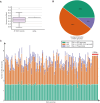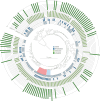Pan-Genome Provides Insights into Vibrio Evolution and Adaptation to Deep-Sea Hydrothermal Vents
- PMID: 39007295
- PMCID: PMC11247349
- DOI: 10.1093/gbe/evae131
Pan-Genome Provides Insights into Vibrio Evolution and Adaptation to Deep-Sea Hydrothermal Vents
Abstract
This study delves into the genomic features of 10 Vibrio strains collected from deep-sea hydrothermal vents in the Pacific Ocean, providing insights into their evolutionary history and ecological adaptations. Through sequencing and pan-genome analysis involving 141 Vibrio species, we found that deep-sea strains exhibit larger genomes with unique gene distributions, suggesting adaptation to the vent environment. The phylogenomic reconstruction of the investigated isolates revealed the presence of 2 main clades: The first is monophyletic, consisting exclusively of Vibrio alginolyticus, while the second forms a monophyletic clade comprising both Vibrio antiquarius and Vibrio diabolicus species, which were previously isolated from deep-sea vents. All strains carry virulence and antibiotic resistance genes related to those found in human pathogenic Vibrio species which may play a wider ecological role other than host infection in these environments. In addition, functional genomic analysis identified genes potentially related to deep-sea survival and stress response, alongside candidate genes encoding for novel antimicrobial agents. Ultimately, the pan-genome we generated represents a valuable resource for future studies investigating the taxonomy, evolution, and ecology of Vibrio species.
Keywords: Vibrio; antibiotic resistance genes; comparative genomics; deep-sea hydrothermal vents; pan-genome; virulence factors.
© The Author(s) 2024. Published by Oxford University Press on behalf of Society for Molecular Biology and Evolution.
Figures






Similar articles
-
Deep-sea hydrothermal vent bacteria related to human pathogenic Vibrio species.Proc Natl Acad Sci U S A. 2015 May 26;112(21):E2813-9. doi: 10.1073/pnas.1503928112. Epub 2015 May 11. Proc Natl Acad Sci U S A. 2015. PMID: 25964331 Free PMC article.
-
Novel isolates of hydrogen-oxidizing chemolithoautotrophic Sulfurospirillum provide insight to the functions and adaptation mechanisms of Campylobacteria in shallow-water hydrothermal vents.mSystems. 2024 Sep 17;9(9):e0014824. doi: 10.1128/msystems.00148-24. Epub 2024 Aug 21. mSystems. 2024. PMID: 39166872 Free PMC article.
-
Genomic Analysis Reveals Adaptation of Vibrio campbellii to the Hadal Ocean.Appl Environ Microbiol. 2022 Aug 23;88(16):e0057522. doi: 10.1128/aem.00575-22. Epub 2022 Aug 2. Appl Environ Microbiol. 2022. PMID: 35916502 Free PMC article.
-
An abyssal mobilome: viruses, plasmids and vesicles from deep-sea hydrothermal vents.Res Microbiol. 2015 Dec;166(10):742-52. doi: 10.1016/j.resmic.2015.04.001. Epub 2015 Apr 22. Res Microbiol. 2015. PMID: 25911507 Review.
-
Genetic adaptations of marine invertebrates to hydrothermal vent habitats.Trends Genet. 2024 Dec;40(12):1047-1059. doi: 10.1016/j.tig.2024.08.004. Epub 2024 Sep 13. Trends Genet. 2024. PMID: 39277449 Review.
Cited by
-
Milestones in Vibrio Science and their Contributions to Microbiology and Global Health.Ann Glob Health. 2025 May 13;91(1):23. doi: 10.5334/aogh.4711. eCollection 2025. Ann Glob Health. 2025. PMID: 40385502 Free PMC article. Review.
-
Draft genome sequence of the marine halophile Vibrio diabolicus strain 3098.Microbiol Resour Announc. 2025 Jan 16;14(1):e0094024. doi: 10.1128/mra.00940-24. Epub 2024 Dec 19. Microbiol Resour Announc. 2025. PMID: 39699277 Free PMC article.
-
Prokaryotic communities associated with marine hydrothermal systems of the Gulf of California.Front Microbiol. 2025 Jan 17;15:1501893. doi: 10.3389/fmicb.2024.1501893. eCollection 2024. Front Microbiol. 2025. PMID: 39895940 Free PMC article.
-
Distribution and Evolutionary Trajectories of β-Lactamases in Vibrio: Genomic Insights from Carbenicillin-Hydrolyzing Class A β-Lactamases (CARB) in the Harveyi and Cholerae Clades.Genome Biol Evol. 2025 Jul 3;17(7):evaf128. doi: 10.1093/gbe/evaf128. Genome Biol Evol. 2025. PMID: 40556499 Free PMC article.
-
Polyethylene terephthalate (PET) primary degradation products affect c-di-GMP-, cAMP-signaling, and quorum sensing (QS) in Vibrio gazogenes DSM 21264.Microbiol Spectr. 2025 Jul;13(7):e0018125. doi: 10.1128/spectrum.00181-25. Epub 2025 Jun 9. Microbiol Spectr. 2025. PMID: 40488468 Free PMC article.
References
-
- Ahmed R, Rafiquzaman SM, Hossain MT, Lee J-M, Kong I-S. Species-specific detection of Vibrio alginolyticus in shellfish and shrimp by real-time PCR using the groEL gene. Aquac Int 2016:24(1):157–170. 10.1007/s10499-015-9916-5. - DOI
-
- Andrianasolo EH, Haramaty L, Rosario-Passapera R, Bidle K, White E, Vetriani C, Falkowski P, Lutz R. Ammonificins A and B, hydroxyethylamine chroman derivatives from a cultured marine hydrothermal vent bacterium, Thermovibrio ammonificans. J Nat Prod. 2009:72(6):1216–1219. 10.1021/np800726d. - DOI - PMC - PubMed
-
- Auguste M, Rahman FU, Balbi T, Leonessi M, Oliveri C, Bellese G, Vezzulli L, Furones D, Canesi L. Responses of Mytilus galloprovincialis to challenge with environmental isolates of the potential emerging pathogen Malaciobacter marinus. Fish Shellfish Immunol. 2022:131:1–9. 10.1016/j.fsi.2022.09.048. - DOI - PubMed
MeSH terms
Grants and funding
LinkOut - more resources
Full Text Sources

